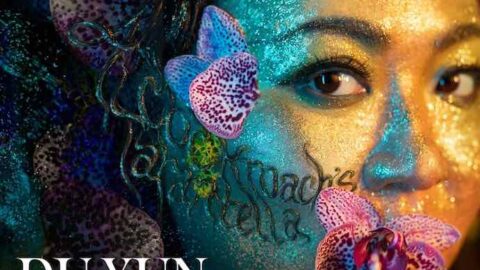A Cockroach’s Tarantella is the latest collaboration between JACK Quartet and composer Du Yun. Released on August 13, 2020 by Modern Sky Ltd., the album is a mixture of recent compositions and world premieres. Scored for narrator, string quartet, and electronics, the titular work seeks to define and underscore the meaning of life and the existential dread that all of us feel, even cockroaches. Two narrated versions of A Cockroach’s Tarantella appear on the album, one in English and another in Chinese, both of which are performed by the composer herself.
A bit of a misnomer as epilogues tend to follow story endings, the album’s first track, “Epilogue,” serves as a beginning and features JACK Quartet’s brilliant improvisational prowess. Pitch bends between intervallically distant notes produce a light chromaticism and an atmosphere of general malaise. The slow, yet pulsing tempo contributes to the feeling of cycling between stress and relief. “Epilogue” also features a field recording by news reporter Yang Nan on the first day a market in Wuhan, China opened after having been closed due to the ongoing COVID-19 pandemic.

Told from the perspective of a female cockroach named Uodfy, A Cockroach’s Tarantella begins with an exclamation of pregnancy. The quartet enters loudly and abruptly with a flurry of activity to underscore the excitement. Narrow melodic gestures are followed by more jagged riffs of only two or three notes. These fragmented moments turn into pointillistic chaos in the second movement, “I am Bored.” Call-and-response gestures keep JACK Quartet and Du Yun’s excited, animated, and tonally-varied narration in constant dialogue with one another, while the pacing of the narration and accompaniment quicken to signal impending rhythmic and melodic mayhem. The lack of a tonal center instills a sense of fear and unpredictability for the listener, as if to represent the almost human emotions that cockroaches might feel: joy, happiness, rage, or panic.
Middle movements such as “Next Life,” “Our Village,” and “The Impossible” maintain a balance between consonant, tranquil sustains and interruptions from the narrator to continue the ongoing story. The application of extra pressure on the bow against the strings creates a scratchy tone that is jarring and provides sonic variety. Repeated glissandi are passed around from instrument to instrument, imitating the sounds of sirens. Rhythmic gestures and sudden changes in dynamics and tone mimic the erratic behavior of cockroaches, often appearing and disappearing almost without a trace. These movements further highlight JACK Quartet’s skills as an ensemble, whose technical abilities are excellent.
In the penultimate movement of the piece, “Muilliska,” Du Yun introduces electronics and processing for the narrator’s vocals. Bell-like tones and whistles coupled with intermittent plucking and bowing all come together to produce an arid cacophony, emphasizing the uncertainty of existing in our modern world that is reiterated throughout the work. Ending with “Ocean,” sounds of flowing water painted by sparse textures help to finish off this cockroach’s journey.
Du Yun’s intention to reflect the often tense relationship between humans and cockroaches is cleverly realized by combining spoken text with the various timbral possibilities of the string quartet, which anthropomorphizes these insects. The inclusion of a version of A Cockroach’s Taratenlla in Chinese is reflective of the dualities of Du Yun’s identity as a Chinese-American immigrant and as a composer-performer. Her pride in those identities is unapologetic and provides important framing for understanding why nearly half of the album is dedicated to the same work in a second language.

Tattooed in Snow for string quartet features a controlled dissonance and a more formal structure than the rest of the album. Mostly stepwise melodic figures evoke a sense of nostalgia and sentimentality, while tight harmonies provide a greater feeling of cohesion. The dense textures, scratchy tones, and hurried rhythmic motives that appeared in A Cockroach’s Tarantella also shine through Tattooed in Snow. A perception of distance and uncertainty permeates the work–it is difficult to tell if this is a result of the composition, or of the socially-distanced times in which we are all living. However, the style of this piece successfully complements the rest of the album.
Recorded during COVID-19 lockdowns, which has made the production of new music challenging, A Cockroach’s Tarantella is a timely album. JACK Quartet’s precise performance and malleability brilliantly realizes the composer’s intentions. Du Yun’s imaginative telling of her own story as a composer-performer is fascinating. Her style invites the listener in to explore the breadth of musical possibilities through a diversity of textures, tones, and melodies that present new and relevant thematic and programmatic ideas.
I CARE IF YOU LISTEN is a program of the American Composers Forum, funded with generous donor and institutional support. A gift to ACF helps support the work of ICIYL. Editorial decisions are made at the sole discretion of the editor-in-chief. For more on ACF, visit the “At ACF” section or composersforum.org.
























